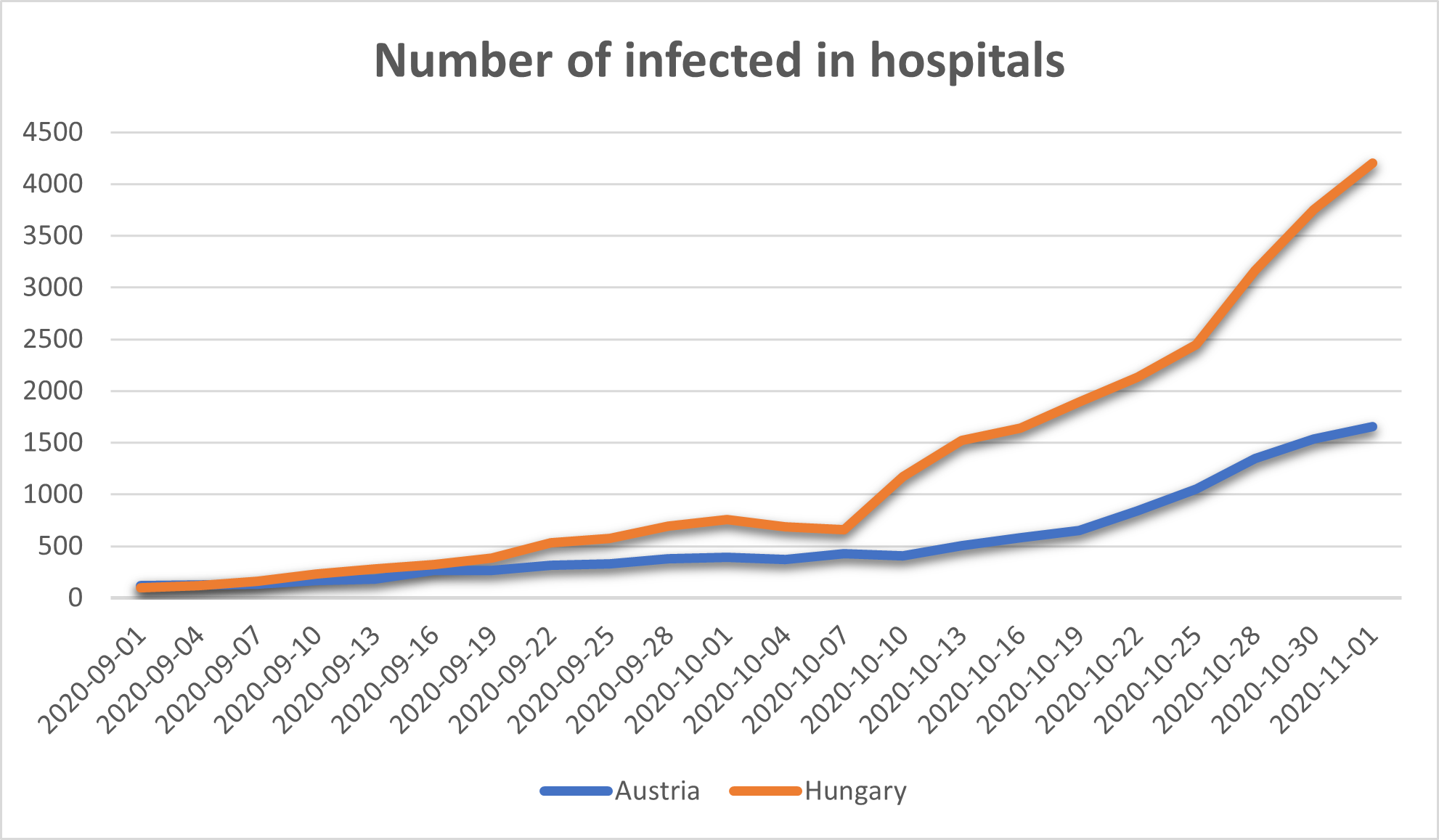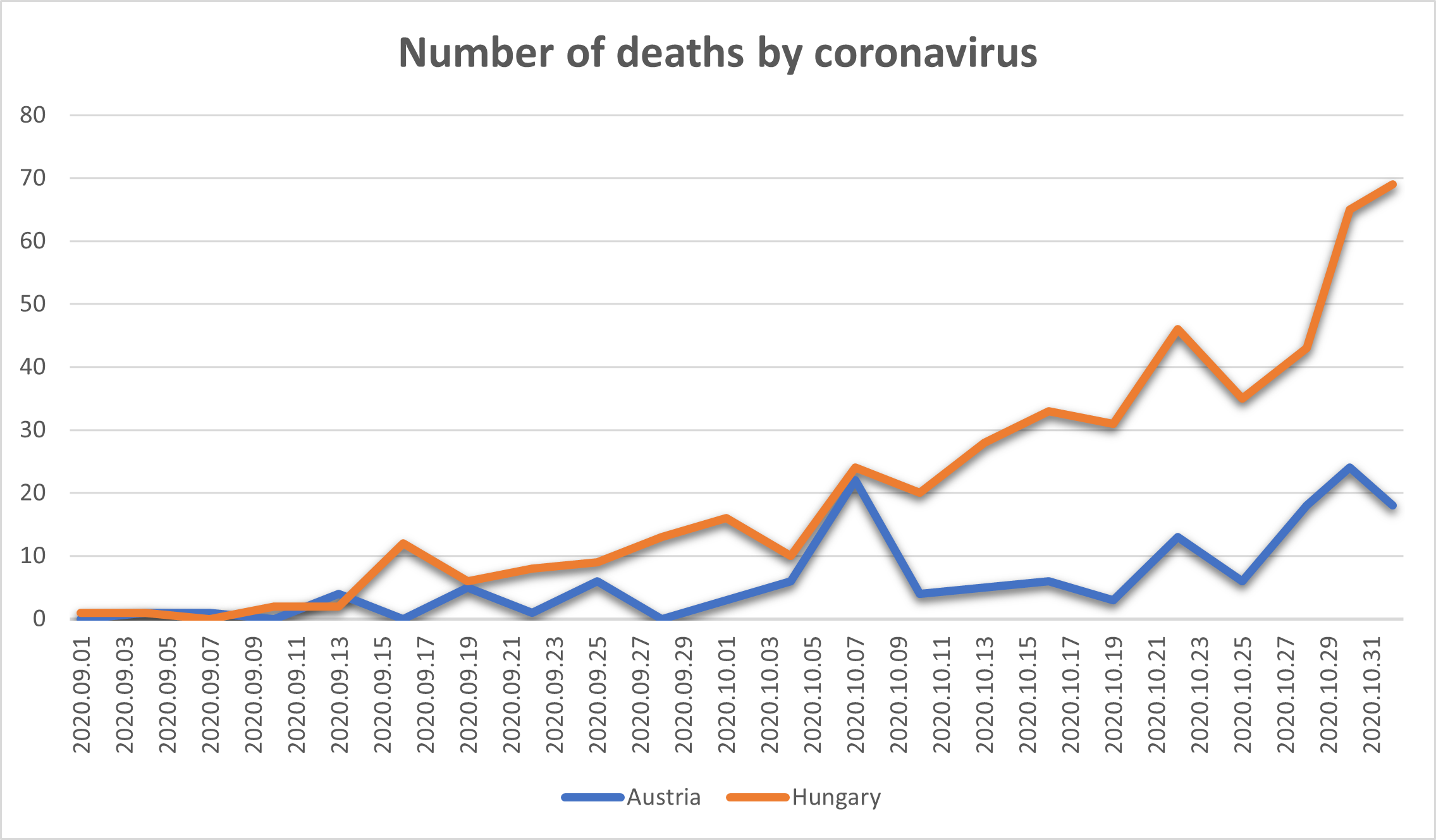Total lockdown in Austria – will Hungary follow?
During the spring, it was common practice that whatever Austria did to control the coronavirus, Hungary also followed suit within one or two weeks. The Hungarian government has not failed to follow this method; in fact, it became a theme – or did it? Seems like it might not be the case. Not only because there is no two-week or one-week delay between the two countries, but also because Austria and Hungary are taking a different path in the pandemic management.
If we were to compare the data of the two countries, there would be nothing supporting the theory that the Hungarian situation is like Austria’s. Index compared the data of the two countries. The data they used is not the most up-to-date, but it is from the European Centre for Disease Prevention and Control (ECDC), which eliminates methodological differences.
No serious conclusions can be drawn from the number of infected people. In week 44 – the ECDC uses a weekly breakdown –, Austria had 26,800 registered infections and Hungary had 19,900. In proportion to the population, i.e. per 100,000 inhabitants, this means 303 cases in Austria and 204 in Hungary. This would imply that the situation is worse in Austria. It should be noted, however, that Austrians test more, i.e. the higher number of positive cases can simply result from more testing.

Data independent of the number of tests performed is much more eloquent.
These are the number of coronavirus patients treated in the hospital, the number of patients on a ventilator, and the number of deaths daily or on a cumulative basis. Neither data sets give cause for optimism, and neither shows any indication that Hungary follows Austria in any way.
Hungary pulled away, but not how it was supposed to
From the data, it seems that Austria can control the spread of the pandemic much better than Hungary can. Index compared the data of the two countries between September 1st and November 1st. At the beginning of September, Austria was a little bit worse, but it was more or less the same as Hungary: about a hundred people were hospitalised in both countries, seven were sent to the intensive care unit in Hungary, while this number was 30 in Austria, and about one or two patients died daily.
Two months later, more than 4,000 infected people were hospitalised in Hungary and more than 300 were in the intensive care unit. The daily number of deaths was close to 70 and even went over 100 several times. Compared to Hungary’s 4,205 coronavirus patients in hospitals, only 1,657 people needed care on the 1st of November in Austria.
The most important difference is in the mortality rate. While in Hungary, the daily mortality data is 69, in Austria, it is only 18. The daily data is, of course, somewhat unreliable, as the fluctuation can be significant, so it is worth looking at it in a larger time frame. Cumulative data is not much better either: between the 1st of September and the 1st of November, a total of 364 patients died in Austria while 1,205 died in Hungary.

Hungary had three times as many deaths caused by coronavirus than Austria in just two months.
The data shows that in Austria, although there are more confirmed cases – the number of tests is higher as well – there are far fewer severe patients, and even fewer are dead.
Two weeks behind
The gap began to grow sometime in the second week of October. During this period, there were no serious restrictions in Hungary nor in Austria, but shortly after, Austria gradually introduced restrictive measures. At first, from October 23, they made the use of masks mandatory, then they prohibited the gathering of large groups of people. From the 1st of November, Austria introduced a curfew, and restaurants were closed. High schools and higher education institutions have switched to digital education in Austria as well.
Hungary implemented these restrictions with a delay of about one and a half weeks. It is said that Austria was Hungary’s “guinea pig”. However, this is certainly not the case anymore, as Hungary already had more hospital patients and a higher death rate in the second half of October than Austria.
After all, Austria, which is in a more favourable position, has taken all the steps sooner than Hungary did.

Read alsoHungarian discoveries, developments, and patents to fight the coronavirus

Read also“We are not equipped well” – An insider’s perspective on Hungarian hospitals
Source: Index.hu
please make a donation here
Hot news
Hungarian economy minister Nagy meets German counterpart in Berlin
BREAKING NEWS – Terror alert raised higher in Hungary, says pro-government site
Extreme Weather Alert: Hungary braces for thunderstorms and cold front!
Hungarian government to prioritise setting up EU cardiovascular strategy during presidency
Hungary among the best holiday destinations with cheap beer in Europe
New European Bauhaus: Hungarian project receives EU prize




6 Comments
I think it should be noted by the writer of this article that these numbers are mostly the elderly and people with advanced cancers, compromised immune systems from diabetes, morbid obesity and alcoholism. All of the articles being written about covid 19 try to instill fear in the general public. The truth is the seasonal flu claims as many people as the covid 19 virus. There is an agenda to wreck the global economy and force an economic resit with a cashless society, forced vaccinations or permanent quarantine of refusers and the inability to buy and sell without a proof of being vaccinated. Don’t you folks see what is happening worldwide. This is insanity. I am not denying that the virus exist at all but most healthy people that contract it recover in less than 2 weeks if they even have any symptoms.
@Wake up I agree that COVID is greatly exaggerated, just look at the numbers and set your emotions aside for a little while. Let people decide for themselves if they want to lock themselves up or ‘take the risk’ of continuing life like they’ve always done. This is tyranny that is being orchestrated by big Tech, biz and globalists politicians. Don’t fall for it!
I would like to ask the previous commentators what alternative they offer.
I mean, we all do as we please, fine, and then? What is the State supposed and expected to do with those who get sick and necessitate hospital care? And what when all hospitals and icu will be full and health care workers missing? Do we put people to die on the street?
And i bet that if you two get sick you will demand to be cured, for i doubt you will want to die. Advise: grow up and put narcisism aside, childhood is over and covid is not a joke.
P.s. those who emphasise that virus mostly kill elders and sicks seem to ignore that elders and sicks, in Hungary in particular, but not only in Hungary, constitute a significant percentage of the population. Tens and tens of thousands, not few hundreds.
Mario Government is never here to help the people NEVER. It is only available to help businesses and those special interest with an agenda. I want no help from anyone. I can take care off myself just fine. I have been seen by a Dr just once in the past 9 years and that was only because my wife said I had a suspicious spot on my back that she thought could be a skin cancer. It wasn’t. The best way for a healthy person to become ill is to visit a Dr. Their chemical cocktails cause more problems that they solve and their suggestions about healthy living are laughable. WE are all going to die someday. THAT is a fact. I for one want nothing to do with vaccines, hospitals and anything that Mario and his religion of science have on offer.
Anonymous, i am not offering anything to you and you are not the only one here who is healthy and lives healthy etc.
However, my question is: what alternative do you suggest to lockdown, since so far lockdown seems to be the only way to reduce pressure on hospitals and icu units?
The moment the Health Care infrastructure will not be able to handle the number of patients necessitating urgent care, what do you recommend they do?
You seem to forget that Covid is causing hospitals to overwork, because there is not only Covid, Covid is only an additional and not insignificant burden on an already very weak H.C.System.
Give a sensible alternative, or else lockdown remains the only solution.
P.s. do not quote Korea or Japan as examples, for measures implemented there can not be implemented here, because of privacy laws etc.
Mario, I want totally open borders, no face mask, no testing, no vaccines, no nothing. Can it be any more clearer than that.? This virus is no more deadly than the seasonal flu. Thousands die from that every year and it is the same groups of people dying, the elderly, those with compromised immune systems and the usual health problems. All of this fearporn from the media is not needed, The entire planet is being massively lied to. Will you ever wake up? Judging by the comments you make here, I doubt anyone could get your attention even if they smacked you in the head.